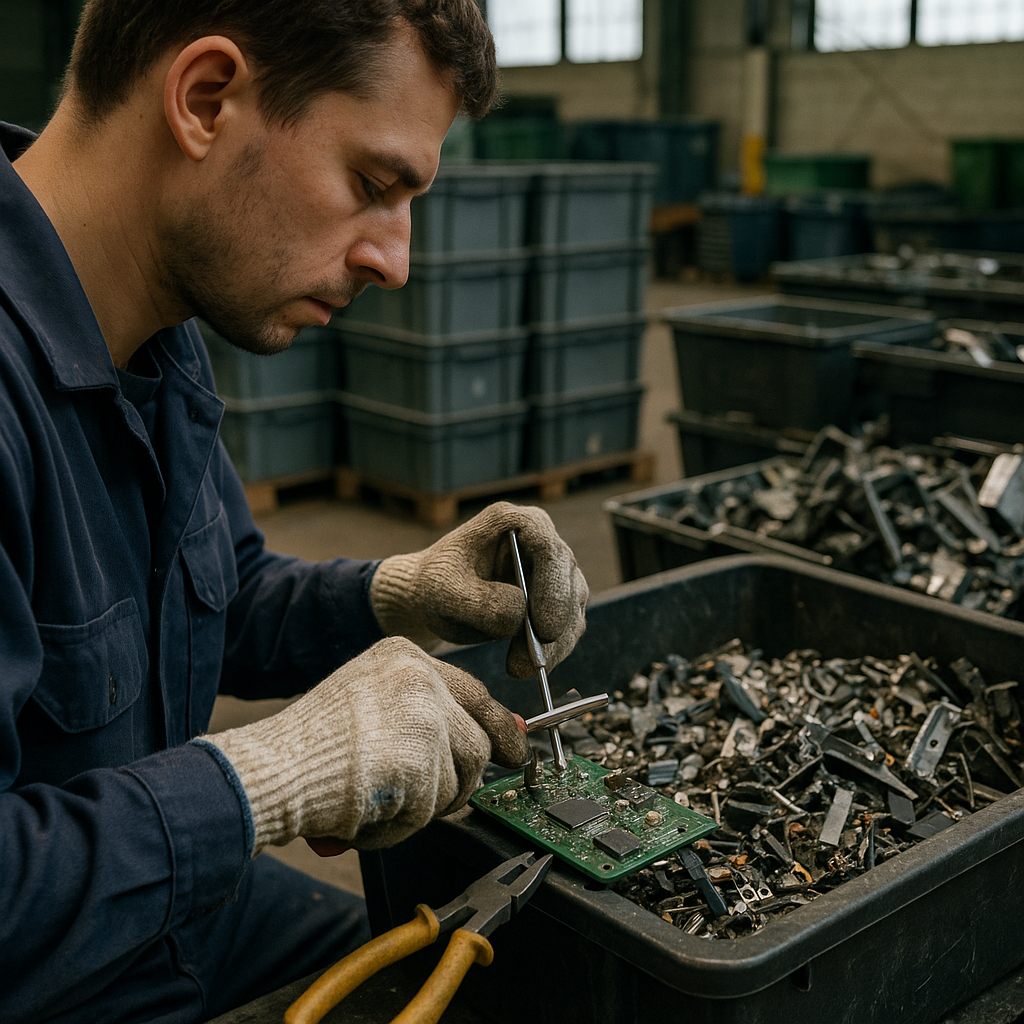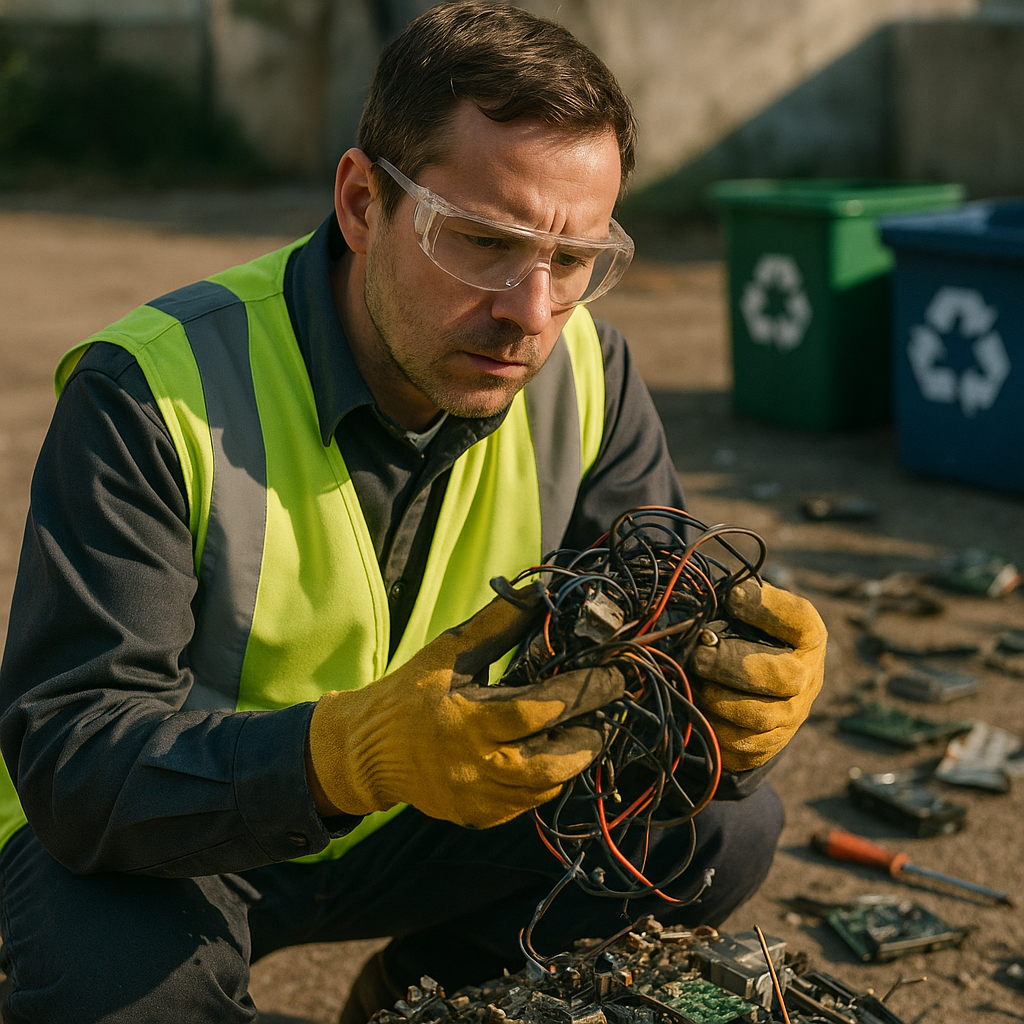5901 Botham Jean Blvd, Dallas, TX 75215
Tantalum Recycling Process: A Quick Beginner’s Guide
October 21, 2025Tantalum is a rare, highly corrosion-resistant metal with exceptional electrical properties, making it invaluable in modern electronics. Found primarily in capacitors, superalloys, and electronic components, tantalum’s unique ability to store large amounts of electrical charge in a small volume has made it essential in today’s increasingly miniaturized digital world.
The tantalum recycling process involves recovering this valuable metal from various scrap sources. These sources include electronic components like capacitors, cemented carbides used in cutting tools, and superalloys found in jet engines and turbines.
The process begins with the collection and sorting of tantalum-containing materials, followed by separation techniques that isolate the metal from other components.
What Are the Main Sources of Recyclable Tantalum?
Tantalum, a valuable metal known for its exceptional properties like corrosion resistance and high melting point, can be recovered from various sources. Recycling tantalum is crucial not only for preserving this critical raw material but also for reducing environmental impacts associated with primary mining.
Major Sources of Recyclable Tantalum
- Electronic Components – The electronics sector accounts for over 60% of global tantalum consumption, making it the most significant potential source for recycling. Tantalum capacitors are especially valuable due to their high tantalum content. These capacitors are found in smartphones, laptops, automotive electronics, and medical devices. Despite their high tantalum content, recycling rates remain low due to processing complexities and challenges in extracting tantalum from printed circuit boards.
- Manufacturing Scrap – New scrap generated during the production of tantalum-based products represents a major recycling stream. This includes off-cuts and waste from capacitor manufacturing, where tantalum powder escapes during the anode pressing process, as well as tantalum wire remnants often referred to as “pins.” These materials are typically returned directly to processors for recycling.
- Cemented Carbide Tools – Tantalum carbide is used in the manufacture of cemented carbide inserts and cutting tools for metalworking applications. These tools typically contain about 3% tantalum, which enhances their wear resistance and performance in high-temperature environments. The recycling of these tools is well-established, with both chemical and zinc processing methods used to recover the valuable metals they contain.
- Superalloy Components – Tantalum is added to nickel-base and cobalt-base superalloys to increase their strength and improve oxidation resistance. These superalloys are primarily used in jet engine parts and gas turbine components. Discarded jet engine components, with an estimated 20-year lifetime, represent a significant source of old tantalum-bearing scrap. Some superalloys can contain up to 12% tantalum, making them valuable recycling sources.
- Chemical Processing Equipment – Due to tantalum’s exceptional corrosion resistance, it is used in chemical plant equipment such as heat exchangers, condensers, and reactor linings, especially for processing corrosive materials like sulfuric acid. These components, though less common than electronic applications, contain significant amounts of tantalum that can be recovered at the end of their service life.
The recycling efficiency for tantalum is largely determined by how well these materials are collected and processed. While new manufacturing scrap has high recovery rates, old scrap (particularly from electronics) has much lower recycling rates—less than 1% according to some estimates. This represents a significant opportunity for growth in tantalum recycling, especially as technology develops to more efficiently recover tantalum from complex electronic waste streams.
How is Tantalum Extracted from Scrap Materials?

The extraction method for tantalum from scrap materials varies based on the source. Each type of material requires a specific approach to efficiently recover this valuable metal while maintaining its purity.
For cemented carbides containing tantalum, two main recycling methods are used: chemical processing and zinc processing. Chemical processing treats carbide scraps with different metal contents to extract tungsten and cobalt first. The tantalum collects in an oxide sludge, becoming suitable for further extraction. This method works with almost any type of cemented carbide scrap.
Zinc processing targets hard scrap like used tool inserts. This method dissolves the binder phase of cemented carbides without altering the composition. Zinc metal is added to the scrap in a vacuum furnace at high temperatures, breaking down the hard metal structure into powder form. The zinc is then removed by distillation, creating a powder used directly in blends with virgin carbides.
Superalloy scrap containing tantalum undergoes different treatment methods due to the complexity of the alloys, which contain numerous elements. The process typically involves melting in electric arc or vacuum furnaces. Vacuum arc or electron beam melting is used for processing metal feedstocks made of powder or high-quality scrap.
For electronic components, particularly tantalum capacitors, recycling begins with leaching to remove other materials like manganese. The capacitors are disintegrated and processed to recover tantalum, often as tantalum oxide. Advanced methods include high-temperature oxidation, which heats tantalum capacitors to decompose the mold resin and liberate the tantalum at temperatures between 700°C and 1,200°C.
Other extraction techniques for electronic scrap include ionic liquid extraction, steam gasification, physical separation followed by heat treatment, pyrolysis, and supercritical water treatment. Each offers specific advantages depending on the type of scrap and the desired purity of the recovered tantalum.
The recycling efficiency varies by material type. For cemented carbides, approximately 35% is recycled using chemical processes and about 25% through zinc processes. The remaining material is typically not recycled. Despite being the primary use for tantalum, electronic components currently have the lowest recycling rates due to challenges in collection and processing.
What Are the Challenges in Tantalum Recycling?

Recycling tantalum faces several significant obstacles that limit its recovery rates. A primary issue is the lack of proper infrastructure for collecting and processing electronic waste containing tantalum. Without dedicated collection systems and processing facilities, much of this valuable metal ends up in landfills instead of being recovered.
Component miniaturization further complicates tantalum recovery efforts. As electronic devices become smaller and more compact, tantalum components contain less material per unit and are harder to access and separate. This paradox requires more labor to extract smaller amounts of tantalum, making the economics of recycling increasingly difficult.
The complex composition of tantalum-containing alloys presents another hurdle. Tantalum is often combined with other metals or incorporated into intricate electronic assemblies, complicating separation and recovery. In capacitors, tantalum anodes are typically encased in resin molds that must be removed before reclamation, adding steps and costs to the recycling process.
These challenges result in limited recycling efficiency. According to data from 1998, only about 35% of old tantalum scrap was successfully recovered and reused, with the majority going unrecovered. Although modern techniques may have improved this rate somewhat, tantalum recycling remains significantly behind other metals. This inefficiency is particularly concerning given tantalum’s critical role in modern technology.
Conclusion: The Future of Tantalum Recycling

The future of tantalum recycling depends on developing more efficient recovery processes from electronic waste. This stream represents a largely untapped reservoir of this critical metal. With end-of-life recycling rates below 1%, there is substantial room for improvement in reclaiming this valuable resource.
The electronics industry uses about 40% of global tantalum production, primarily in capacitors for smartphones, tablets, and other devices. As these technologies grow, demand will continue to rise. Without improved recycling methods, we face increasing supply risks and environmental challenges from primary mining operations. The environmental benefits are clear—recycling tantalum from electronic waste requires significantly less energy and produces far fewer carbon emissions than extracting it from virgin sources.
For sustainable resource management to become a reality, closer collaboration between the tantalum industry and electronics recyclers is essential. This partnership would enable the development of standardized collection systems, investment in advanced separation technologies, and the creation of economic incentives that make tantalum recycling financially viable.
For organizations looking to improve recycling operations or implement sustainable materials management, contact Okon Recycling at 214-717-4083.
